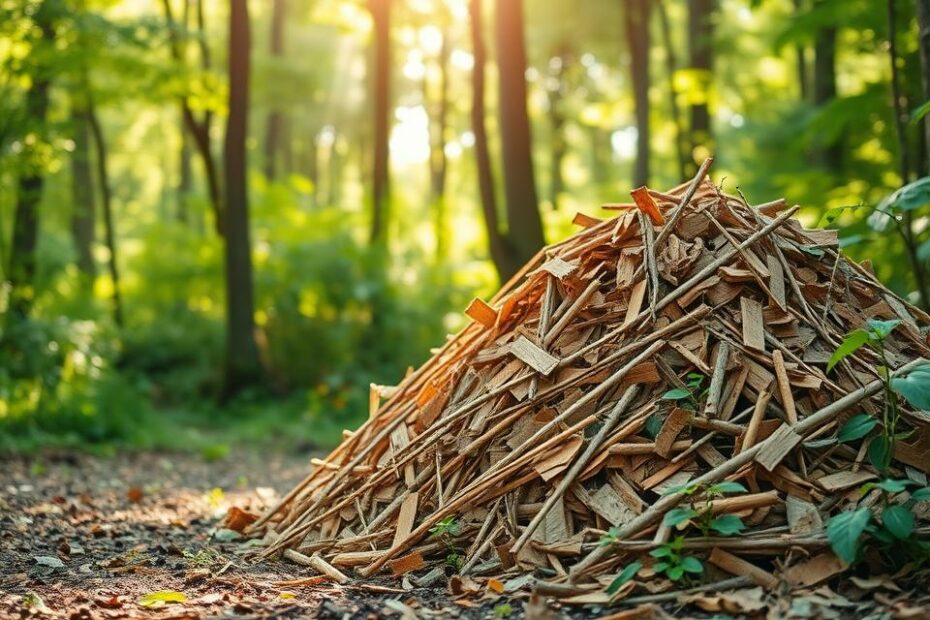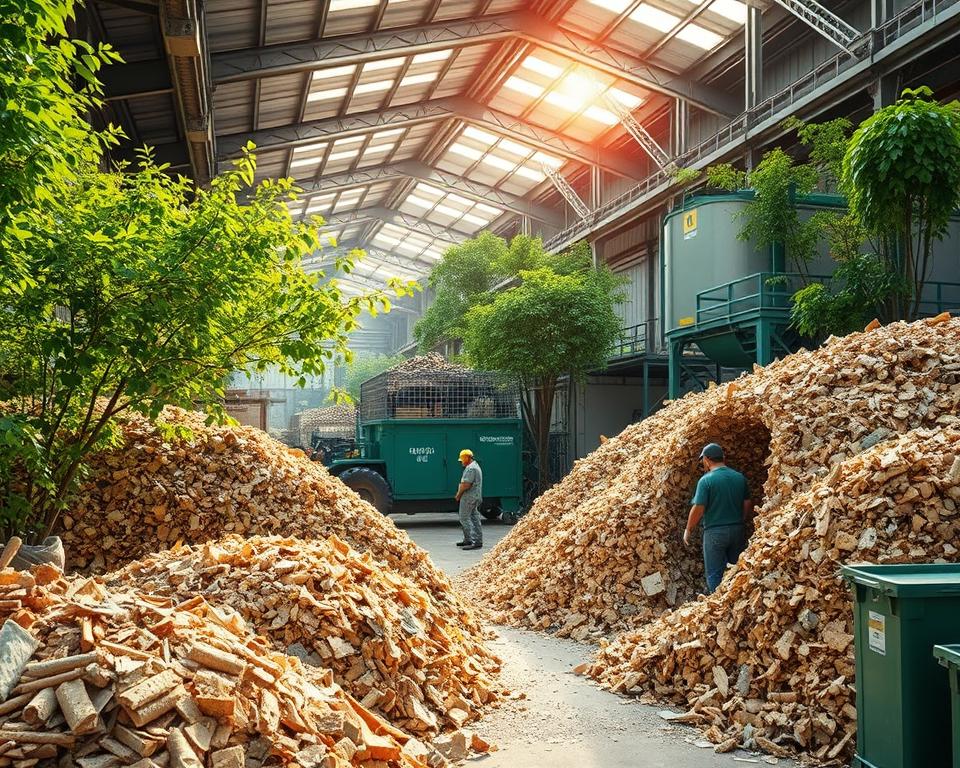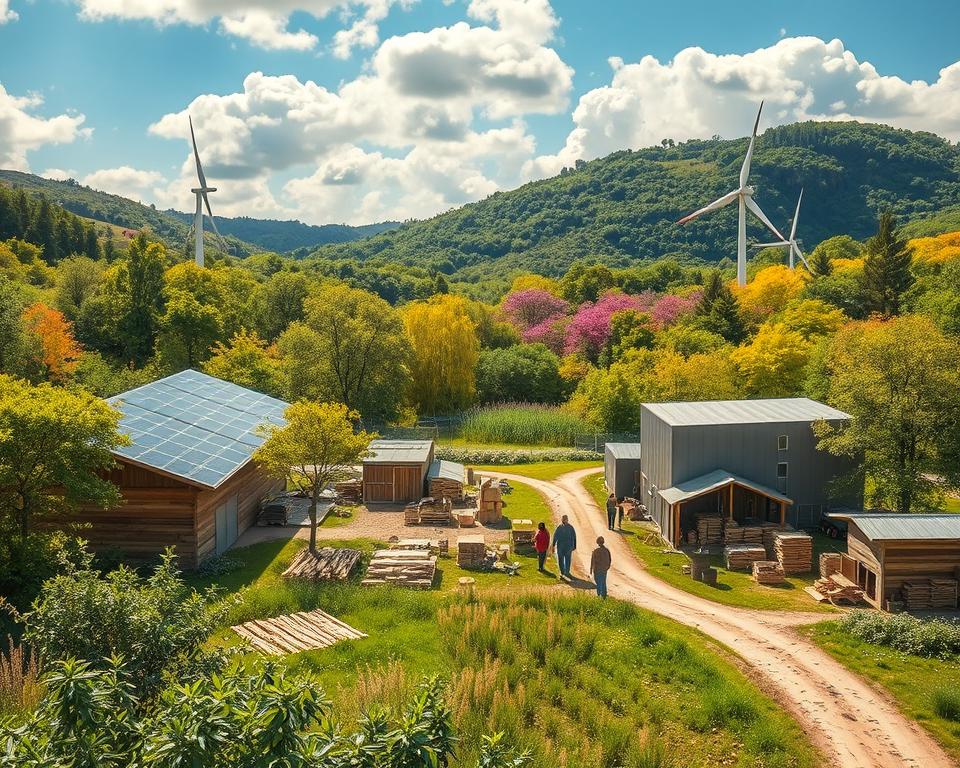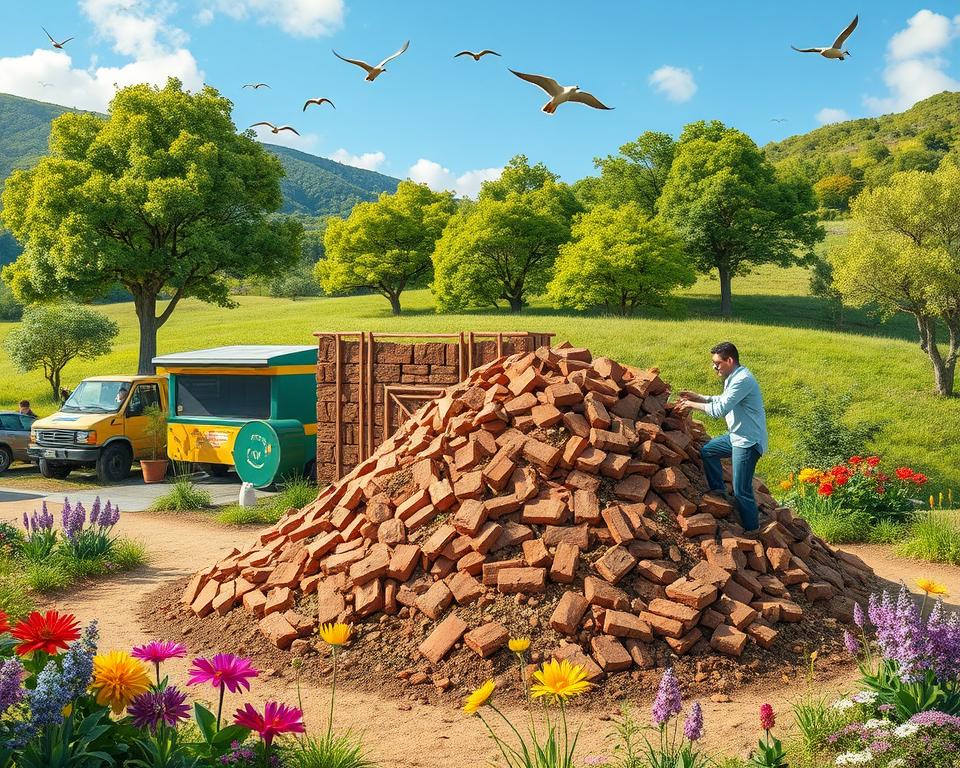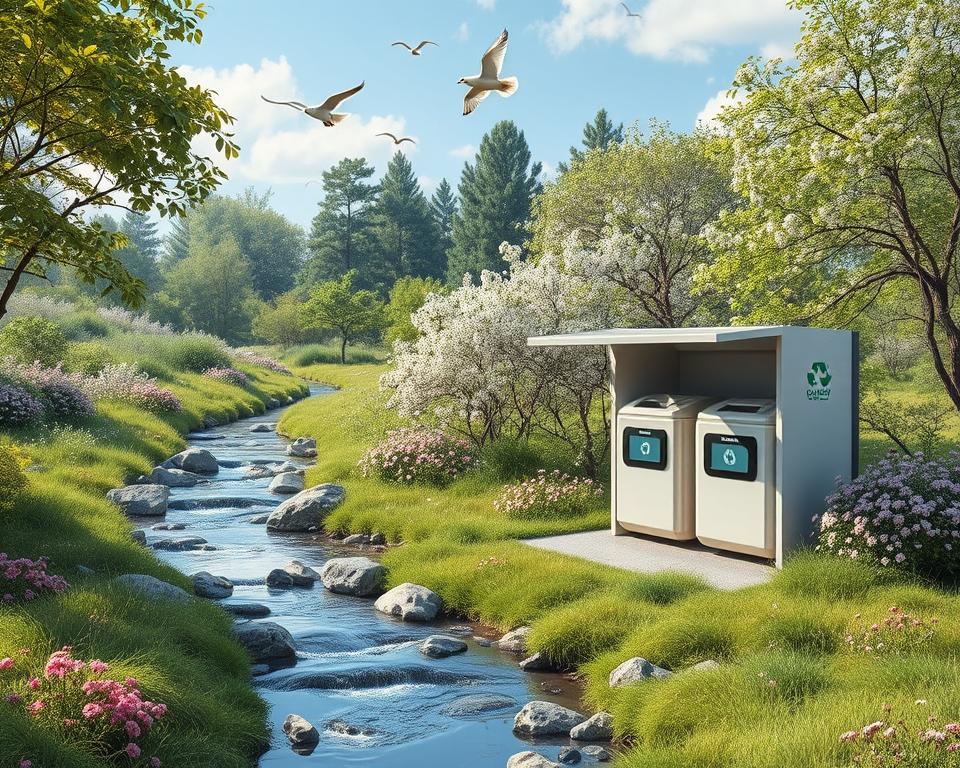I’m always looking for ways to live more sustainably. Today, I want to talk about how to dispose of chipboard responsibly. Chipboard is everywhere, and how we get rid of it matters a lot.
Our actions affect the planet, and how we throw away waste is key. If we don’t dispose of chipboard right, it can harm the environment. We need to find better ways to get rid of it.
In this article, we’ll look at safe and green ways to get rid of chipboard. We’ll explore creative ideas and recycling methods. Let’s work together to make our planet a better place for all.
Introduction to Sustainable Chipboard Disposal
In today’s world, taking care of chipboard waste disposal is very important. Chipboard is a common building material, but it’s hard to dispose of it in an eco-friendly way. It’s key for both people and businesses to use eco-friendly chipboard disposal methods.
The Environmental Impact of Chipboard Waste
Chipboard, made from wood particles and resin, can harm the environment if not thrown away right. Bad chipboard waste disposal can pollute soil and water and even cause deforestation. Knowing how chipboard waste affects the planet is the first step to recycling and disposing of it responsibly.
Why Proper Disposal Matters
Using eco-friendly chipboard disposal helps keep our planet safe and saves resources. Good chipboard waste disposal cuts down on landfill waste and lets us recycle chipboard. This way, we can make new things and use less raw materials. By choosing sustainable chipboard recycling and responsible chipboard disposal practices, we help the planet and support a circular economy.
Understanding Chipboard Composition
Chipboard, also known as particle board, is a versatile and widely used material. It’s key in the construction and furniture industries. Knowing what chipboard is made of helps us find the best ways to dispose of it. It’s made from wood chips, sawdust, and resin, all pressed together under heat and pressure.
The main parts of chipboard are:
- Wood Particles: Chipboard’s main strength comes from wood chips, sawdust, and shavings.
- Resin: Synthetic resins like urea-formaldehyde or melamine-formaldehyde hold the wood particles together.
- Wax: A bit of wax is added to make the surface water-resistant and smooth.
The exact makeup of chipboard can change based on how it’s made, the wood type, and its use. Knowing this is key for chipboard waste disposal and industrial chipboard waste management. Different types need different recycling methods.
Understanding chipboard’s complex makeup helps everyone make better choices. It ensures chipboard waste is handled safely and in an eco-friendly way.
Reusing and Repurposing Chipboard
Reusing and repurposing chipboard is a great way to be eco-friendly. It helps reduce waste and supports sustainability. By turning old chipboard into new items, we can lessen its environmental harm. Plus, it lets us show off our creativity.
Creative Ideas for Repurposing Chipboard
Chipboard is very versatile. It can be used in many creative ways. Here are some ideas to give your chipboard a new life:
- Furniture Making: You can make furniture like shelves, storage units, coffee tables, and desks from chipboard. With some creativity and carpentry skills, you can make it both functional and stylish.
- Art and Crafts: Chipboard’s flat surface and strength are perfect for art projects. You can paint, collage, or make decorative wall hangings. The options are endless for creative expression.
- Organizational Solutions: Use chipboard to make storage and organization systems. You can make boxes, trays, and dividers for your home or office. These solutions help declutter and organize your space.
- Eco-Friendly Packaging: Chipboard can be turned into eco-friendly packaging. It’s a great alternative to plastic or cardboard. It shows your commitment to the environment.
By reusing and repurposing chipboard, we help the planet and show off our creativity. We turn ordinary materials into amazing creations.
Recycling Chipboard: A Greener Solution
Recycling chipboard is a key step in reducing our environmental footprint. It’s a greener choice than throwing it away. The chipboard recycling process turns old chipboard into new, useful items.
The Chipboard Recycling Process
The recycling chipboard journey has several important steps. Let’s explore them:
- Collection: Items like furniture and packaging are gathered from homes, businesses, and construction sites.
- Sorting and Preparation: The chipboard is sorted and cleaned to remove contaminants like metal and plastic.
- Shredding and Pulping: The chipboard is then shredded or pulped into smaller pieces.
- Reprocessing: The pulp is turned into new chipboard products, like furniture and flooring, using special machines.
- Quality Control: The final products are checked to make sure they’re safe and meet quality standards.
Choosing sustainable chipboard recycling helps cut down on waste. It’s a step towards a greener future.
| Benefits of Chipboard Recycling | Challenges of Chipboard Disposal |
|---|---|
| Reduces landfill waste | Limited biodegradability |
| Conserves natural resources | Potential for toxic chemicals |
| Supports a circular economy | High disposal costs |
| Creates new job opportunities | Lack of awareness about recycling |
Dispose Chipboard: Eco-Friendly Methods
It’s important to dispose of chipboard in a way that’s good for the planet. Luckily, there are many ways to do this. Let’s look at some of these green options:
Recycling Chipboard
Recycling chipboard is a great way to be eco-friendly. It can be broken down and turned into new things. This helps save resources and cuts down on waste. Many recycling centers will take chipboard and show you how to recycle it right.
Composting Chipboard
If you can compost, chipboard is a good addition. It breaks down and makes soil for plants. This method helps keep waste out of landfills and supports a green economy.
Eco-Friendly Chipboard Disposal through Waste Management
If recycling or composting isn’t an option, use your local waste management. Proper disposal in designated areas helps chipboard be handled well. This keeps our environment safe.
| Eco-Friendly Chipboard Disposal Method | Advantages | Considerations |
|---|---|---|
| Recycling | Conserves natural resources, reduces waste | Availability of local recycling facilities |
| Composting | Provides nutrient-rich soil, diverts waste from landfills | Access to composting facilities |
| Proper Waste Management | Ensures responsible handling and processing | Availability of specialized haulers or collection sites |
By choosing these eco-friendly chipboard disposal methods, we can all help the planet. This is true for both individuals and businesses.
Industrial Chipboard Waste Management
Managing industrial chipboard waste is key to sustainable waste disposal. Businesses that produce a lot of chipboard waste need to use eco-friendly methods. This helps reduce harm to the environment.
Best Practices for Industrial Chipboard Disposal
Choosing the right way to dispose of industrial chipboard is vital. It supports responsible chipboard disposal practices and eco-friendly chipboard disposal. Here are some top tips:
- First, understand how much and what type of chipboard waste you have.
- Focus on reuse and repurposing before sending it to landfills.
- Set up recycling programs or work with specialized recyclers.
- Teach your team how to handle and store chipboard waste correctly.
- Keep up with local and national rules on industrial chipboard disposal.
- Work with others in your field, environmental groups, and government to improve disposal methods.
By following these steps, companies can manage their industrial chipboard waste in a way that’s good for the planet. This helps create a greener future for all.
Responsible Chipboard Disposal Practices
It’s important to dispose of chipboard in a way that’s good for the environment. Homeowners and businesses should follow eco-friendly practices. This helps us meet local rules and supports the circular economy.
Recycling chipboard is a key part of responsible disposal. It keeps valuable materials out of landfills and helps the planet. To recycle, find chipboard recycling facilities near you and follow their rules.
Also, we can reuse chipboard for creative projects. This way, it doesn’t end up in landfills. We can make furniture, wall panels, or decorations from it.
| Responsible Chipboard Disposal Practices | Benefits |
|---|---|
| Recycle chipboard | Diverts waste from landfills, supports the circular economy |
| Repurpose or reuse chipboard | Extends the life of the material, reduces waste |
| Dispose of chipboard properly according to local regulations | Ensures responsible waste management, protects the environment |
By following these responsible chipboard disposal practices, we help the planet. Every small action towards eco-friendly disposal makes a big difference.
Finding Chipboard Recycling Facilities Near You
It’s important to dispose of chipboard waste the right way. This helps the environment and supports sustainable practices. We’ve put together a guide to find chipboard recycling facilities near you.
Tips for Locating Reliable Chipboard Recyclers
Finding good chipboard recycling facilities can seem hard. But, with some tips, you can make sure your waste is recycled right. Here’s how to find the best places:
- Search online for “chipboard recycling facilities” in your area. Read reviews to see if they’re good.
- Ask your local government if they have a list of approved chipboard recycling places.
- Talk to waste management groups or green organizations in your area about sustainable chipboard recycling.
- Choose places that are open about their chipboard recycling process and care for the environment.
- Think about how easy it is to get to the recycling place. Look at their hours and location.
By using these tips, you can find chipboard recycling facilities that match your green goals. This way, your chipboard waste will be handled right.
| Recycler Name | Location | Services Offered | Sustainability Practices |
|---|---|---|---|
| Eco-Chip Recycling | 123 Main Street, Anytown, USA | Chipboard recycling, waste management | Uses energy-saving tools, recycles 95% of chipboard |
| Green Fiber Recycling | 456 Oak Avenue, Othertown, USA | Chipboard recycling, furniture upcycling | Turns recycled chipboard into new items, follows zero-waste rules |
| Sustainability Solutions | 789 Maple Boulevard, Newcity, USA | Chipboard recycling, industrial waste management | Has advanced sorting tech, offers full recycling programs |
The Future of Sustainable Chipboard Disposal
The world is waking up to the need to protect our environment. This has made sustainable chipboard recycling and eco-friendly chipboard disposal more important. New recycling technologies and the circular economy are leading the way to a better future.
New recycling methods are being developed. These can break down chipboard into its parts, like wood fibers and resins. This makes it possible to use these materials again, reducing waste and saving resources.
There’s also a focus on finding new ways to dispose of chipboard. This includes using it for building or turning it into fuel. These ideas help reduce waste and promote sustainable chipboard recycling and eco-friendly chipboard disposal.
As people and businesses care more about the environment, they’ll want better disposal options. This will lead to more research and development in recycling and disposal. It will help make the impact of chipboard waste much less.
Conclusion
Disposing of chipboard in an eco-friendly way is key to protecting our planet. We’ve looked at what chipboard is and how to recycle it. This guide helps you manage chipboard waste responsibly.
Reusing and recycling chipboard can greatly lessen its harm to the environment. We’ve shown you how to give chipboard a new life. Also, finding good places to recycle is crucial to ensure chipboard is handled right.
The future of chipboard disposal is in our hands. It’s about working together to use eco-friendly methods. By being informed and supporting recycling, we can make a difference. This will help our planet and create a better future for chipboard and other waste.
FAQ
What are the eco-friendly ways to dispose of chipboard?
Eco-friendly ways to get rid of chipboard include recycling and repurposing. Recycling breaks it down for new products. Repurposing finds creative uses for it. Proper waste management also helps.
How can I recycle chipboard?
Recycling chipboard starts with collecting and sorting it. Then, it’s broken down and processed for new use. Many recycling centers and waste companies offer this service.
What are the benefits of recycling chipboard?
Recycling chipboard helps the environment a lot. It cuts down on landfill waste and saves natural resources. It also supports the circular economy by keeping materials in use.
How can I find a chipboard recycling facility near me?
Look online for local recycling centers or waste companies that take chipboard. Your local government might also have info on recycling options.
What are some responsible chipboard disposal practices?
To dispose of chipboard responsibly, try to use less and find new uses. Properly sort and dispose of any leftover waste. Always follow local rules and work with trusted waste services.
